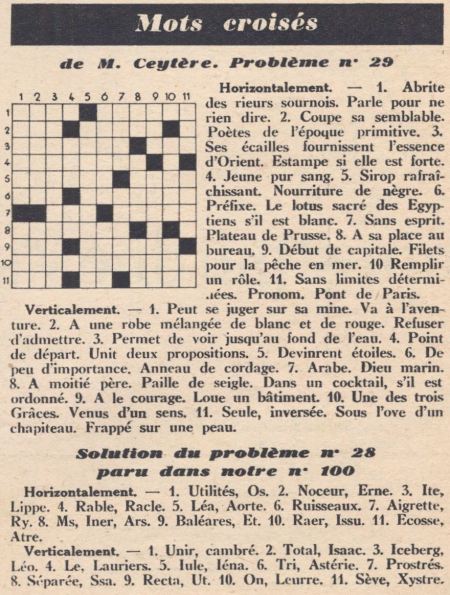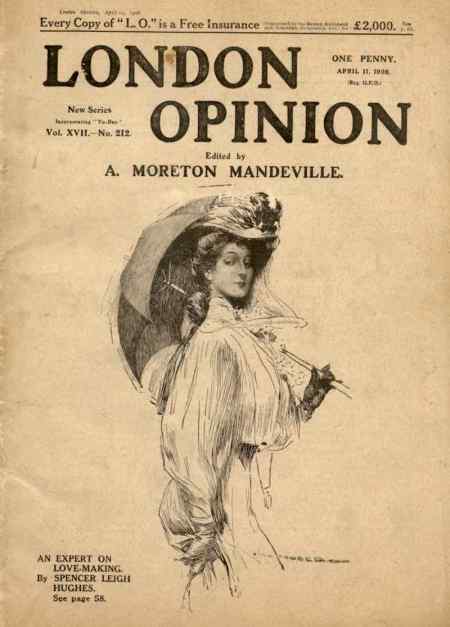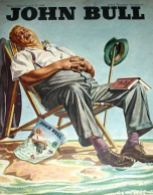
Lika Joko first issue cover in 1894. It was ‘conducted’ by Harry Furniss
Harry Furniss was a popular black and white artist of the late Victorian and Edwardian periods who launched his own magazine, Lika Joko in 1894 after he left Punch. The name was a pun on ‘like a joke’ and one of his noms-de-crayon. Like many periodicals of the time, the cover was dominated by advertising.
Note how Furniss portrays himself alongside the magazine’s title with his quill pen piercing the artist’s palette and the nib appearing to be covered in blood – the pen being mightier than the sword. He is dressed in a kimono with sheets of paper held in place at his back by the belt. The patterns on the kimono are formed from parts of his signature. The lettering of the title also has a Japanese feel. Furniss had produced a series of cartoons, ‘Our Japanneries’, under the name Lika Joko in 1888, pretending to be ‘the celebrated Japanese Artist … who is now on a visit to this country’. In the late Victorian period, Japan had a huge influence of art in Britain, resulting in a phenomenon known as Japonisme. Japan and Britain were great allies until World War II.

How Harry Furniss portrayed Mr Punch and Toby in the Lika Joko editorial
On Punch, Furniss was renowned for his quick-fire caricatures of MPs in parliament for the Essence of Parliament pages, which were collated into books, but he turned his pen to all sorts of subjects and illustrated many books. RGG Price in his History of Punch (1957) says: ‘During the years of his Punch work, Harry Furniss dominated the pages. He was all over the place with jokes, illustrations, dramatic criticisms, headings and parliamentary sketches … It is said that he would chat to a man and caricature him on a pad held in his pocket.’
One of his cartoons in the satirical weekly was a spoof on advertising for A&F Pears (now part of Unilever), which used endorsements from celebrities such as the actress and notable beauty, Lillie Langtry, to sell its translucent amber soap. The spoof (26 April 1884) showed a tramp writing a letter saying:
I used your Soap two years ago; since then I have used no other.
Furniss and Punch fell out when the magazine sold the copyright in the drawing to Pears for use in advertising. Price describes Furniss as being ‘dictatorial and slick’ over the issue and the Punch people as ‘patient and disinterested’ in their correspondence. Despite this, the Pears advert was carried on the back cover of the first issue of Lika Joko – see at the bottom of this post – though with a slightly different caption. Pears used the Furniss cartoon advert at least for 16 years – I have a copy of it in a 1910 issue of TP’s Magazine.
 |
 |
|
Pears took the Millais painting ‘A Child’s World’, added a bar of soap by the boy’s foot to advertising reproductions, and called it ‘Bubbles’
|
Pears famously turned another image, the painting ‘A Child’s World’ by the Pre-Raphaelite artist John Millais, into advertising – the image became so famous because it was reproduced as colour lithographs millions of times over several decades. Thomas Barratt, the company’s managing director, bought the painting from Illustrated London News owner Sir William Ingram, who had reproduced it in the magazine as a colour poster for a Christmas issue. Pears had the image copied with a bar of its soap added and today we know it as ‘Bubbles’.
Barratt has been described as ‘the father of modern advertising’ for his innovative strategies. The boy in the painting was the artist’s grandson, Willie James, who later became a Royal Navy admiral. Like Pears’ soap, ‘Bubbles’ is now owned by Unilever and is on loan to the Lady Lever art gallery in Port Sunlight, on the Wirral. Copies of the colour advertising can be seen online from the V&A museum catalogue.

Pears took the back page of Lika Joko with its Harry Furniss advert
Lika Joko lasted for just 26 issues, from 20 October 1894 to 13 April 1895. Price describes how Furniss was refused a gallery ticket to parliament for Lika Joko – a disaster for a political caricaturist – and that this proved fatal to the paper. Later, Furniss went to the US, where the Internet Movie Database lists him as directing, writing and appearing in three films for Edison Studios, a company controlled by the inventor Thomas Edison: The Mighty Hunters and The Artist’s Joke (1912), and Rival Reflections (1914). Furniss returned to Britain and has been credited with helping to pioneer animated cartoon films in 1914 with War Cartoons and Peace and Pencillings. The BFI credits Furniss on 15 films.
There is a short film online at Brighton University, Winchelsea and its Surroundings. A Day with Harry Furniss and his Sketchbook, which shows Furniss at the cottage of Helen Terry and painting the actress. Other scenes are filmed in Winchelsea and Hastings.
Price reckons Furniss made a lot of money but lost most of it to making films. He died in 1925, in the seaside town of Hastings, where he is buried.
The National Portrait Gallery has a self-portrait of Furniss and more than 450 of his sketches for sale online as prints.
>> Harry Furniss profile in Tit-Bits, alongside Sir Leslie Ward (‘Spy’ of Vanity Fair) and the theatrical caricaturist Alfred Bryan
>> More on Punch, a weekly satirical magazine that lasted 150 years
 To see almost 500 magazine covers and pages, look out for my book, A History of British Magazine Design, from the Victoria & Albert Museum, the world’s leading museum of art and design
To see almost 500 magazine covers and pages, look out for my book, A History of British Magazine Design, from the Victoria & Albert Museum, the world’s leading museum of art and design













 It turns out though, that not only was the illustration jumping on the Beatrix Potter bandwagon, but that it was a copy – or a licensed reproduction of – a cover by Frank Guild from the Ladies’ Home Journal, a US monthly, from Easter the year before.
It turns out though, that not only was the illustration jumping on the Beatrix Potter bandwagon, but that it was a copy – or a licensed reproduction of – a cover by Frank Guild from the Ladies’ Home Journal, a US monthly, from Easter the year before.












 To see almost 500 magazine covers and pages, look out for my book,
To see almost 500 magazine covers and pages, look out for my book, 







































































































